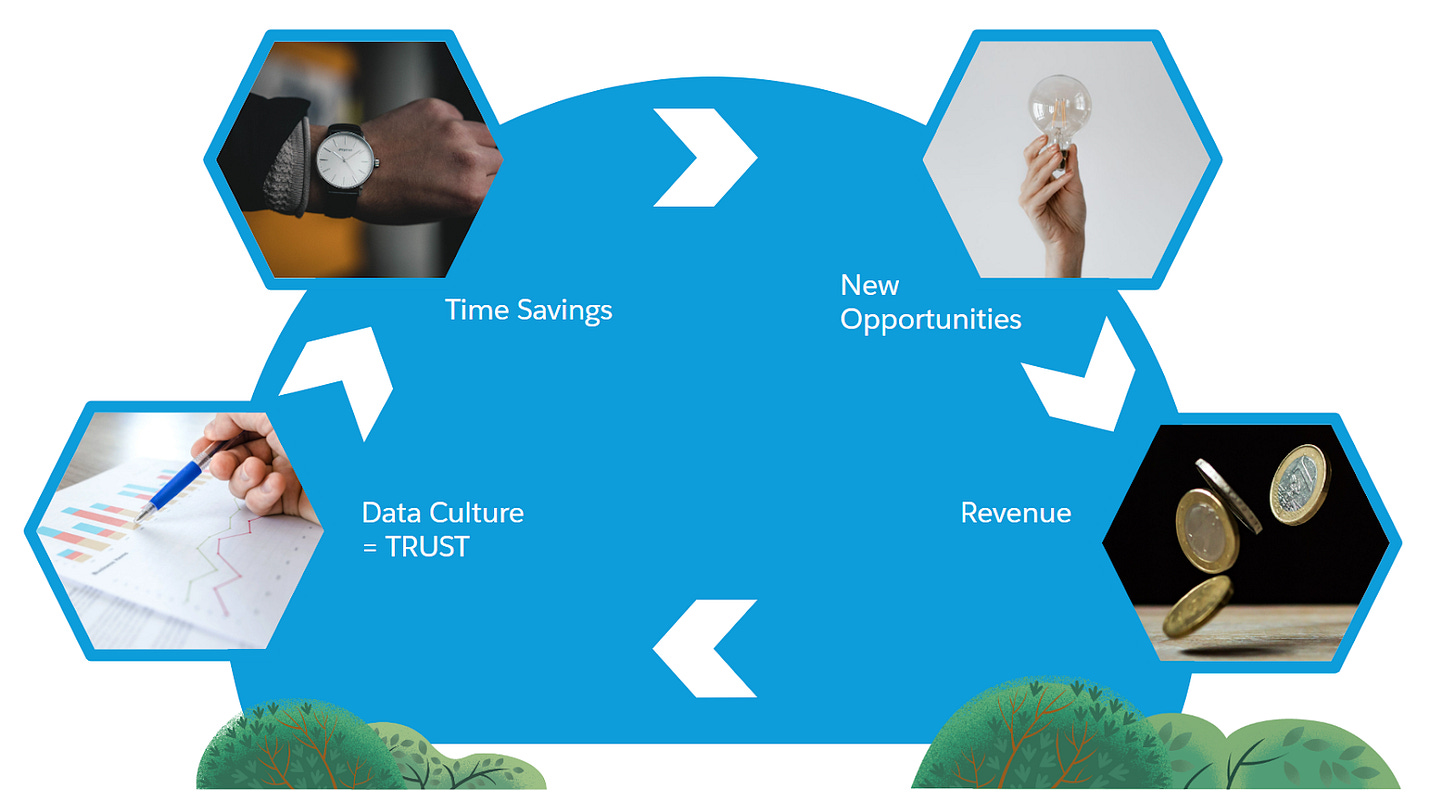I work with clients every day who are trying to make data in their organisation successful, and have analytics and insights work for them. Most of them are well on the way to achieving some success with their data culture, albeit often measured against different baselines and expectations. What’s often clear though is that internal success is no longer the only measure of how successful we are with data.
Success doesn’t just lie in making sure a community of analysts have the tools to understand data and know how to use them. It’s imperative that everyone from Marketing to Sales teams learn to trust data themselves and buy into the data culture in the same way that analysts do, which in turn creates opportunities for the Data Team in other areas. Often those opportunities surface outside the organisation, providing data to clients or suppliers, and helping provide value to them using our data.
This virtuous circle of data culture impacting our external stakeholders which in turn creates revenue opportunities is what is dominating a lot of my conversations with organisations at the moment.
While your measures of success might not look like the next persons, the outcomes and needs for your business and your customers are fundamentally the same: You need to drive revenue for your business by driving value for customers.
In the start of this series on Data Monetisation, I share how we find opportunities to drive revenue for our business by empowering our customers with data.
In this series I’ll touch on:
The Key Principles of Data Monetisation
Common mistakes in monetising products
Identifying Use Cases
Creating great data products for your customers [ideally with an agile, flexible build]
Features that can help build embedded applications that make your customers successful
Adapting to maturing customer demands
Operational Considerations
.
Shall we start back at the beginning though? What is Data Monetisation?
Data Monetisation refers to the process of using data to obtain quantifiable economic benefit. You can do this directly by selling analytics and data to your customers or to third parties, typically as a revenue stream in itself, or as part of an offering that encourages them to purchase more or sign up for premium services.
For example, a bank may monetise their loan pipeline data by visualise the stages of loan applications from submission to approval, providing a clear view of the pipeline. They may track average processing times for each stage to identify bottlenecks and streamline workflows. Furthermore they could analyse approval rates across different customer segments (e.g., first-time buyers, refinances) to identify high-potential segments or adjust qualification criteria
When Ocado spoke at the Tableau conference in 2022, they talked about their tiered offering to buyers as their customers, highlighting how Data Monetisation can really work help push value back to their customers and act as a revenue stream in it’s own right.
Modern Data Monetisation is typically delivered via dashboards and / or self service capabilities via a Web Application / Website with customer specific logins and data filtered to be customer specific.
The Key Principles of Data Monetisation
As you start to think about how to use your data to help improve your services to clients, then it’s important to remember my key mantra in this space Your Data has Value - don’t give it away. It’s amazing how many people I’ve seen forget this fundamental concept and build added value into their existing offering to their clients. It’s easy done, and you might tell yourself you are adding value to customers to help retention rates. However, it devalues your data in the eyes of the customer and stops them paying attention. Cost = Value. If we don’t pay for something we fail to see the value. [At this point I’m reminded of the apocryphal story of the guy who left a Fridge outside his home with a sign saying “Free to a Good Home”. It wasn’t taken after a week or two, so he changed the sign to “£50” and it was stolen the next night.]
A second mistake I’ve seen is simply providing a data extract and delivering it to customers for them to analyse. I feel this is a mistake for a few reasons; firstly it’s perhaps unlikely your customer will prioritise making use of the data and draw out the analytical value you can provide. Secondly, owning the insights and the platform means that you can leverage revenue from providing services.
Let’s think about how you can cut data to monetise it.
Time: Provide slices of historical analysis over time in increasing value propositions. E.g. 1 month free, 6 months Bronze Tier, 12 months Silver Tier, 5 Years Gold Tier.
Filters: Provide different filter options to cut and slice the data by relevant dimensions, again tiering it into output streams.
Use case: Like Ocado above, you can build several use cases with similar datasets, by cutting the data into different views for different uses and providing the insight
Benchmarking: Comparing one customers usage of your services / products and benchmarking it against others creates a compelling use case. Offer tiered cuts of this data by Whole Market (say for free) and smaller more relevant industry segments as a more premium offering.
By building Freemium type offerings you can offer customers immediate value, while generating a revenue stream with higher offerings.
Next weeks article we’ll look at how to identify use cases and start to think about options in terms of delivering analytics to your clients.







